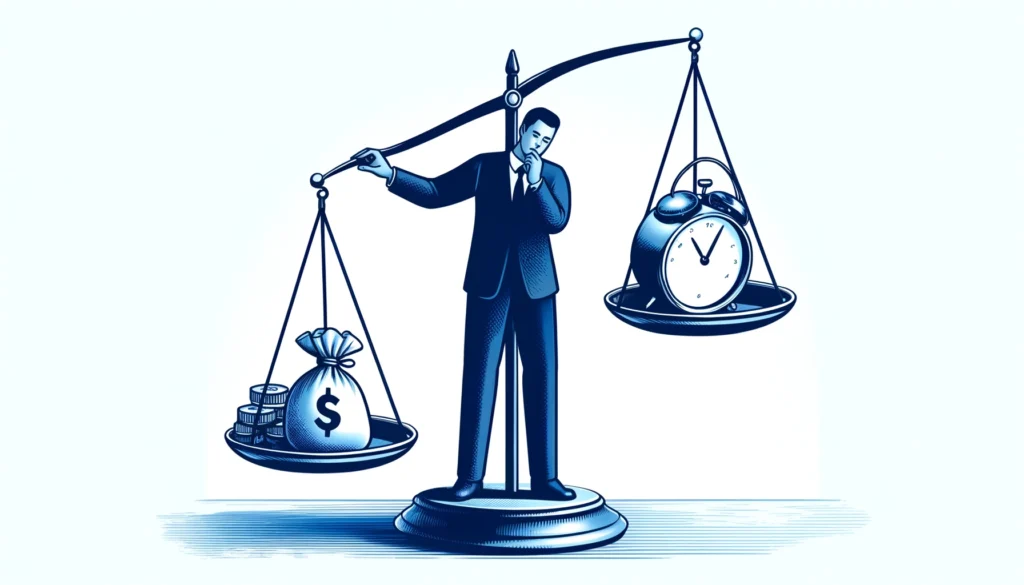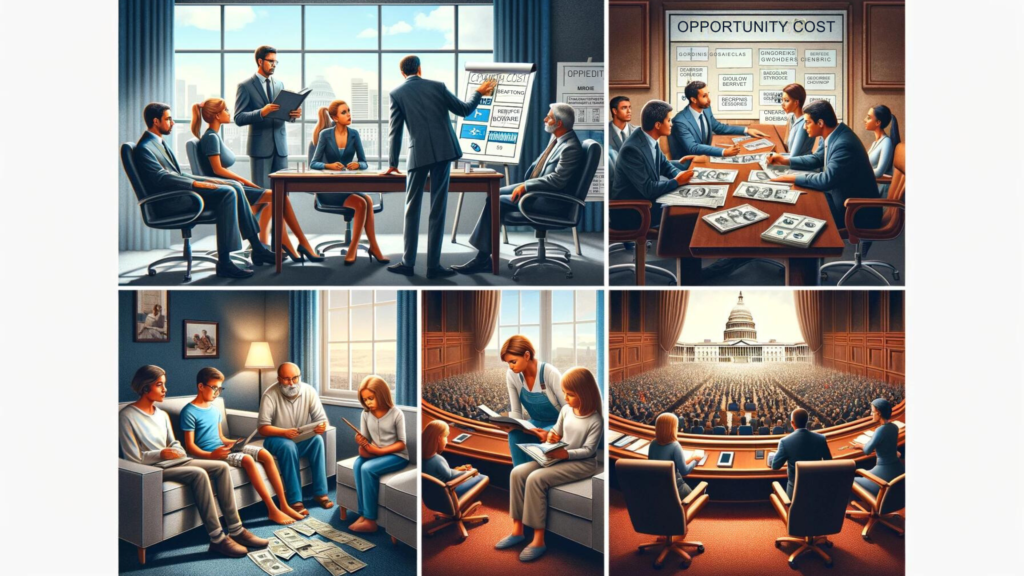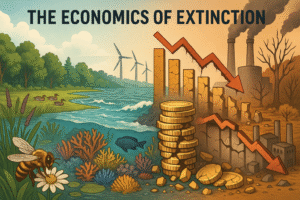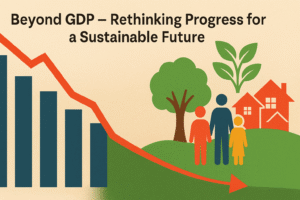Opportunity cost, a fundamental concept in economics, represents the potential benefits an individual, investor, or business misses out on when choosing one alternative over another. At its core, it embodies the essence of decision-making, highlighting the trade-offs that accompany every choice we make, whether in our personal lives or in the business world. Understanding opportunity cost is not just about recognizing the financial implications of our decisions but also about acknowledging the hidden costs associated with forgone opportunities that could shape our future prospects.
This blog post aims to demystify the notion of opportunity cost, illustrating its pivotal role in guiding informed and effective decisions. By delving into how this concept permeates various aspects of daily life, from personal finance to business strategy and time management, we will uncover the profound impact of opportunity cost on shaping our choices and, ultimately, our destinies.
Understanding Opportunity Cost
Opportunity cost refers to the value of the next best alternative that must be forgone as a result of choosing one option over another. This concept is grounded in the principle of scarcity, which asserts that resources are limited, be they time, money, or materials, thus necessitating choices between competing alternatives. At its heart, opportunity cost is about measuring what we lose when we decide to pursue one path over another, making it a crucial consideration in both personal and economic decision-making.
To grasp the concept more concretely, consider a simple everyday decision: if you spend the evening at a movie theater, the opportunity cost is what you could have enjoyed instead, such as reading a book at home or completing an overdue work project. In this scenario, the opportunity cost isn’t just the ticket price, but also the value of the time and satisfaction you sacrifice from not engaging in an alternative activity.

In the realm of economics, opportunity cost plays a vital role in ensuring that resources are used efficiently. For example, a business must often choose between investing in new technology or expanding its workforce. The opportunity cost of investing in technology might be the benefits that additional employees could have brought to the company, such as increased production or improved customer service.
Opportunity cost is not always easily quantifiable, especially when it involves factors like personal satisfaction or quality of life. However, acknowledging and estimating it as best as possible is essential for making informed decisions that align with our goals and values. In essence, understanding opportunity cost helps individuals and businesses to make choices that best utilize their scarce resources, leading to better outcomes in the face of limited options.
Opportunity Cost in Personal Finance
In the realm of personal finance, opportunity cost plays a critical role in guiding individuals through a myriad of financial decisions, from everyday spending to long-term investments. It serves as a hidden force that shapes our financial behaviors and priorities, influencing how we allocate our money to maximize personal and financial well-being.
When considering opportunity cost in personal finance, it’s essential to evaluate the trade-offs between current consumption and future savings. For instance, purchasing a new smartphone may lead to immediate gratification, but it also means forgoing the interest income that could have been earned had the money been saved or invested. Similarly, choosing to spend on a lavish vacation might mean delaying or reducing the amount one can contribute to a retirement fund.

Investment decisions are also heavily influenced by opportunity costs. Opting to invest in a low-risk, low-return savings account might seem safe, but the opportunity cost here includes the potentially higher returns from investing in stocks or bonds. Conversely, while high-risk investments can offer the chance for significant gains, they also come with the opportunity cost of losing principal, which safer investments would have preserved.
Moreover, opportunity cost extends to debt management. Deciding to pay off debt early, especially high-interest debt, might save money in the long run but could mean missing out on investing in opportunities that could yield higher returns than the interest saved from debt repayment.
Budgeting, a cornerstone of personal finance, is also an exercise in understanding opportunity costs. Allocating funds to different categories—like housing, food, entertainment, and savings—requires a careful evaluation of the relative importance and potential benefits of each, ensuring that money is spent in a way that brings the most value to the individual’s life.
Opportunity Cost in Business and Economics
In the business and economic spheres, opportunity cost is a crucial factor in strategic decision-making and resource allocation. It helps companies and economists assess the potential benefits and losses associated with different business strategies, investments, and operational choices, guiding them toward decisions that optimize resource use and enhance value creation.
Businesses frequently face decisions that involve significant opportunity costs. For instance, a company might need to choose between investing in research and development (R&D) to innovate new products or expanding its market presence through increased marketing efforts. The opportunity cost of choosing R&D is the potential market share and immediate revenue that enhanced marketing could have generated. Conversely, prioritizing marketing over product development might lead to short-term sales gains but could sacrifice long-term growth and competitiveness due to a lack of innovation.

Similarly, opportunity cost considerations are pivotal in capital budgeting decisions, where firms decide how to invest their limited capital. Investing in new machinery might improve production efficiency, but the opportunity cost might be the potential profits that could have been realized from using that capital to expand into new markets or develop new products.
In the broader economic context, opportunity cost is central to the concept of comparative advantage, which underpins international trade. Nations specialize in producing goods and services for which they have the lowest opportunity cost, leading to more efficient global resource allocation and increased economic welfare. This principle illustrates how opportunity cost helps to determine not only business strategies but also national economic policies and international trade agreements.
Moreover, opportunity cost is a key consideration in labor economics, where firms must decide on the optimal allocation of human resources. Hiring additional staff in one department means those labor resources are not available for other projects or departments, necessitating a careful evaluation of where employees can be most effectively utilized to contribute to the company’s overall objectives.
Opportunity Cost in Time Management
Opportunity cost is a critical concept in time management, affecting how individuals and organizations prioritize tasks and allocate their time effectively. Time, like money, is a finite resource; every decision about how to spend it involves a trade-off against potential alternative uses.
In personal time management, understanding opportunity cost can lead to more productive and satisfying life choices. For instance, spending an evening watching TV has the opportunity cost of not pursuing a hobby, exercising, or learning a new skill. Each choice reflects a value judgment about what is most beneficial or enjoyable at that moment, with long-term implications for personal development and well-being.

For professionals and businesses, time management through the lens of opportunity cost involves prioritizing tasks that yield the highest value or return. This often means focusing on strategic activities that drive growth and profitability, rather than getting bogged down in routine, low-impact tasks. For example, a business leader might delegate administrative tasks to focus on high-level strategic planning and relationship building, which offer greater long-term benefits to the organization.
Effective time management requires assessing the potential return on investment of different activities. This could mean choosing between responding to emails and working on a project proposal; while both tasks are important, prioritizing the proposal might have a higher opportunity cost if it leads to new business opportunities.
Moreover, time management isn’t just about choosing what to do; it’s also about deciding what not to do. This can involve saying no to requests or opportunities that, while potentially valuable, do not align with one’s highest priorities or goals. By recognizing the opportunity costs associated with these decisions, individuals and organizations can make more deliberate and strategic choices about how to allocate their time.
Real-world Applications and Case Studies
The concept of opportunity cost extends beyond theoretical discussions, manifesting in various real-world scenarios that highlight its significance in decision-making processes. By examining case studies and applications, we can better appreciate the tangible impact of opportunity costs on both personal and professional decisions.
- Personal Finance Decisions
Consider the case of an individual choosing between buying a new car or investing the same amount of money in the stock market. If the car depreciates in value over time while the stock market investment grows, the opportunity cost of choosing the car is the foregone investment gains. A real-world example of this can be seen in the decisions made by investors during market fluctuations; those who choose to hold cash or safe assets during a bull market may miss out on significant gains compared to those who invest in higher-risk, higher-return assets.

- Business Strategic Choices
A classic business case study is Apple’s decision in the early 2000s to focus on developing the iPod and iTunes, which diverted resources from other projects. The opportunity cost of this decision was the potential growth or success of other Apple products or services that were deprioritized. However, this focus ultimately led to Apple’s dominance in the digital music market, illustrating how the concept of opportunity cost plays out in strategic business decisions.
- Time Management in Professional Settings
In the corporate world, a case study often cited is the decision by executives to outsource certain tasks or functions. For instance, a company might outsource its customer service operations to focus on core activities like product development or market expansion. The opportunity cost of not outsourcing could be slower growth or reduced competitiveness due to the diversion of resources and attention from strategic objectives.
- Public Policy and Economic Planning
On a larger scale, government decisions on infrastructure spending reflect opportunity cost considerations. For example, the decision to invest in road construction over public transportation has impacted urban development, traffic patterns, and environmental outcomes for decades. Analyzing historical decisions in urban planning can reveal the long-term opportunity costs associated with prioritizing one form of infrastructure over another.
These real-world examples demonstrate how the concept of opportunity cost permeates various aspects of decision-making, from individual financial choices to large-scale business and governmental strategies. By examining these cases, it becomes clear that understanding and evaluating opportunity costs is vital for making informed decisions that align with long-term goals and objectives.
Conclusion
The concept of opportunity cost is a pivotal element in the tapestry of economic reasoning, serving as a beacon that guides individuals, businesses, and policymakers through the maze of choices and trade-offs that define our lives. Its ubiquitous nature underscores the constant presence of alternatives in every decision we make, reminding us that every choice carries with it the weight of foregone possibilities and potential benefits.
In personal finance, understanding opportunity cost encourages a more mindful approach to spending and investing, prompting individuals to consider the long-term impacts of their financial decisions. In the business realm, it shapes strategic planning and resource allocation, ensuring that organizations pursue paths that promise the greatest returns on their investments. For time management, acknowledging opportunity cost leads to more effective and purposeful use of our most finite resource, time, aligning our daily actions with our broader life goals.
As we have explored through various examples and case studies, the application of opportunity cost in real-world scenarios provides invaluable insights, enabling more informed and effective decision-making. Whether it’s an individual assessing investment options, a business determining its strategic direction, or a government planning its economic policies, the concept of opportunity cost remains a critical tool in the decision-making arsenal.

In summary, the essence of opportunity cost is not merely in quantifying what is lost or gained in making choices but in fostering a deeper understanding of the trade-offs that define our existence. By consistently applying this concept, we can navigate the complex web of decisions we face with greater clarity and confidence, ultimately leading to outcomes that are most aligned with our values, objectives, and long-term aspirations.
Author’s Note
In crafting this exploration of opportunity cost, I aimed to illuminate how this fundamental economic principle permeates various facets of our lives, influencing decisions in personal finance, business strategy, and time management. I hope this blog post not only enhances your understanding of opportunity cost but also empowers you to make more informed choices in your daily life and professional endeavors.
G.C., Ecosociosphere contributor.
References and Further Reading
- “Thinking, Fast and Slow” by Daniel Kahneman – This book delves into how we make decisions and the psychological underpinnings of judgment and choice, including economic decision-making.
- “The Paradox of Choice: Why More Is Less” by Barry Schwartz – Schwartz explores how the abundance of choice in modern society can lead to decision paralysis and dissatisfaction, offering insights into opportunity costs in personal decisions.
- “Nudge: Improving Decisions About Health, Wealth, and Happiness” by Richard H. Thaler and Cass R. Sunstein – Thaler and Sunstein discuss how small changes in the way choices are presented can significantly impact our behavior, highlighting the role of opportunity cost in decision-making.




